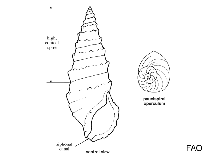Bittiolum varium (Pfeiffer, 1840)
Grass cerithWarning: DOMDocument::load(): SSL operation failed with code 1. OpenSSL Error messages: error:140770FC:SSL routines:SSL23_GET_SERVER_HELLO:unknown protocol in C:\Apache24\htdocs\includes\SpeciesSummary.lib.php on line 1236
Warning: DOMDocument::load(): Failed to enable crypto in C:\Apache24\htdocs\includes\SpeciesSummary.lib.php on line 1236
Warning: DOMDocument::load(https://sealifebase.nrm.se/webservice/AquaMaps/getAMap.php?genus=Bittiolum&species=varium): failed to open stream: operation failed in C:\Apache24\htdocs\includes\SpeciesSummary.lib.php on line 1236
Warning: DOMDocument::load(): I/O warning : failed to load external entity "https://sealifebase.nrm.se/webservice/AquaMaps/getAMap.php?genus=Bittiolum&species=varium" in C:\Apache24\htdocs\includes\SpeciesSummary.lib.php on line 1236
Upload your photos
Google image | No image available for this species;
drawing shows typical species in Cerithiidae.
Google image | No image available for this species;
drawing shows typical species in Cerithiidae.
Classification / Names Common names | Synonyms | CoL | ITIS | WoRMS
| Not assigned | Cerithiidae
Environment: milieu / climate zone / depth range / distribution range นิเวศวิทยา
เกี่ยวกับหินโสโครก; ระดับความลึก 0 - 11 m (Ref. 83435). Tropical; 38°N - 30°S, 98°E - 35°E (Ref. 83435)
การแพร่กระจาย ประเทศต่างๆ | พื้นที่จำแนกตาม FAO | ระบบนิเวศหลายระบบ | การปรากฏขึ้น,การเกิดขึ้น,พบ | การแนะนำ
Western Atlantic: Maryland to Brazil.
Length at first maturity / ขนาด / น้ำหนัก / Age
Maturity: Lm ? range ? - ? cm Max length : 0.7 cm DL เพศผู้/กระเทย; (Ref. 83435)
This species is found in offshore, intertidal and subtidal coral reefs, bays and coves, cienaga facies, reef lagoons, and drift, particularly in algae, ascidian, coral, diatoms, mud, rock, rubble, sand, seagrass, and shell habitats (Ref. 83934).
Life cycle and mating behavior วัยเจริญพันธุ์ | การสืบพันธุ์ | การวางไข่ | เซลสืบพันธ์ของเพศเมีย(ไข่) | ความดกของไข่ | ตัวอ่อน
Members of the order Neotaenioglossa are mostly gonochoric and broadcast spawners. Life cycle: Embryos develop into planktonic trocophore larvae and later into juvenile veligers before becoming fully grown adults.
Main reference
อ้างอิง | ผู้ประสานงาน | ผู้ร่วมมือ
Vittor, B.A. 2001. (Ref. 8431)
IUCN Red List Status (Ref. 130435)
CITES status (Ref. 108899)
Not Evaluated
CMS (Ref. 116361)
Not Evaluated
Threat to humans
Human uses
| FishSource |
เครื่องมือ
ข้อมูลเพิ่มเติม
ประเทศต่างๆ
พื้นที่จำแนกตาม FAO
ระบบนิเวศหลายระบบ
การปรากฏขึ้น,การเกิดขึ้น,พบ
การแนะนำ
Stocks
นิเวศวิทยา
อาหาร, โภชนาการ
รายการอาหาร
พื้นที่จำแนกตาม FAO
ระบบนิเวศหลายระบบ
การปรากฏขึ้น,การเกิดขึ้น,พบ
การแนะนำ
Stocks
นิเวศวิทยา
อาหาร, โภชนาการ
รายการอาหาร
ชื่อสามัญ
ชื่อพ้อง
ผู้ล่า
การสืบพันธุ์
วัยเจริญพันธุ์
การวางไข่
ความดกของไข่
เซลสืบพันธ์ของเพศเมีย(ไข่)
Egg development
ชื่อพ้อง
ผู้ล่า
การสืบพันธุ์
วัยเจริญพันธุ์
การวางไข่
ความดกของไข่
เซลสืบพันธ์ของเพศเมีย(ไข่)
Egg development
Age/Size
การเจริญเติบโต
Length-weight
Length-length
สัณฐานวิทยา
ตัวอ่อน
อุดมสมบรูณ์
การเจริญเติบโต
Length-weight
Length-length
สัณฐานวิทยา
ตัวอ่อน
อุดมสมบรูณ์
แหล่งที่มาจากอินเตอร์เน็ต
BHL | BOLD Systems | CISTI | DiscoverLife | FAO(Publication : search) | Fishipedia | GenBank (genome, nucleotide) | GloBI | Gomexsi | Google Books | Google Scholar | Google | PubMed | แผนภูมิชีวิตแบบต้นไม้ | Wikipedia (Go, ค้นหา) | บันทึกทางด้านสัตววิทยา
Estimates based on models
Preferred temperature
(Ref. 115969): 24.1 - 28.1, mean 27.2 (based on 622 cells).
Price category
(Ref. 80766):
Unknown.



